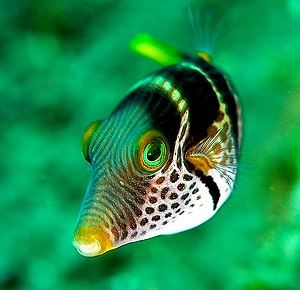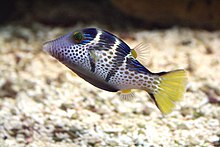Saddle puffer fish
| Saddle puffer fish | ||||||||||||
|---|---|---|---|---|---|---|---|---|---|---|---|---|

Saddle puffer fish ( Canthigaster valentini ) |
||||||||||||
| Systematics | ||||||||||||
|
||||||||||||
| Scientific name | ||||||||||||
| Canthigaster valentini | ||||||||||||
| Bleeker , 1853 |
The saddle-pointed puffer ( Canthigaster valentini ) lives in the Red Sea and the Indo-Pacific from the coast of East Africa to South Africa , Japan , Tuamotu and Lord Howe Island at depths of 1 to 55 meters in coral reefs . Like most species of its genus, it remains quite small with a maximum length of 10 centimeters.
It feeds on red and green algae , as well as on small invertebrates such as small echinoderms , bristle worms , molluscs and bryophytes .
Reproduction
Saddle puffer fish live in harem associations in which one male controls a large area with one to seven territorial females. They spawn each day in the morning hours with a different female of the harem. As a spawning substrate, the females choose an algae pad. Males who do not have a harem try to invade existing harems in order to spawn with a female. When confronted with the harem owner, they imitate a courting female in order to avoid a fight.
Swarms
Every now and then the fish form small schools of up to 100 animals. Individual specimens of the black saddle filefish ( Paraluteres prionurus ) join these schools . This mimics the body color and shape, but especially the saddle spots of the saddle-pointed puffer fish ( mimicry ), which like all puffer fish has poisonous skin and organs. The filefish are thus protected from predators. They never make up more than 5% of the swarm.
Aquaristics

The saddle-pointed puffer fish is suitable as a keeper in the coral reef aquarium. Usually they don't go for corals . The aquarium should be set up with live rock and have a longer standing time so that a diverse fauna of small invertebrates could spread. The puffer fish will be constantly on the lookout for something to eat and will find a large part of its food in the aquarium.
The greatest danger in captivity is that the teeth will not wear off enough if they are fed with larger, more filling frozen food . This allows them to grow so much that the animal can no longer eat and eventually starves to death. To prevent this, you can feed small frozen food such as Cyclops , which is distributed in the aquarium and falls on the stone decoration. The fish learn that they always find food on the stones and that they gnaw on the stones again and again, so that the teeth constantly wear out. You can keep a single animal in a medium-sized aquarium and a pair in a large one.
literature
- Robert Patzner, Horst Moosleitner: Sea water atlas . 6th volume. 1st edition. Mergus Verlag, Melle 1999, ISBN 3-88244-116-X .
